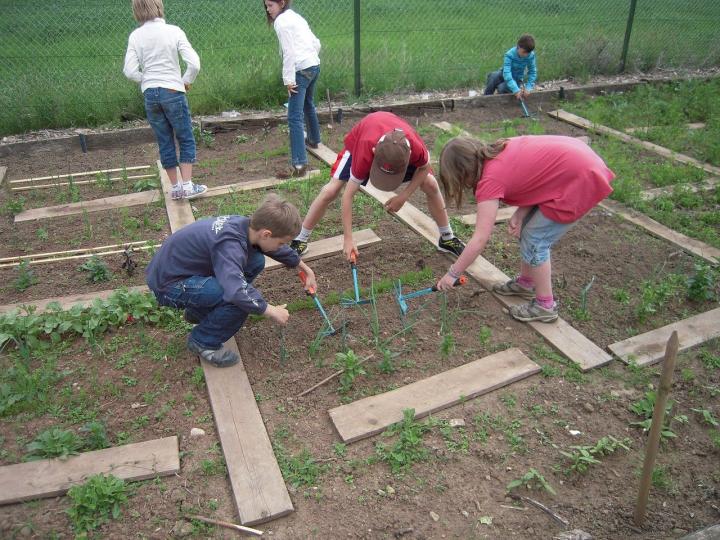Starting a Garden for Children at Home or School
The Almanac Garden Planner - Use It Free for 7 Days!
Plan your 2025 garden with our award-winning Garden Planner.
Children who grow vegetables, eat vegetables. Here’s our advice on how to start a kid’s vegetable garden—at home or at school—plus, a list of great garden plants.
Gardens offer children the chance to get involved in growing food – a skill that will last them a lifetime. Plus, gardening is fun, sparking children’s natural curiosity!
Many of today’s health problems can be traced to poor diet, so it stands to reason that people who grow their own food should be happier and healthier. Get kids involved in gardening from an early age, so they develop an understanding of where fresh food comes from and an appreciation of just how delicious it can be.
If you’re creating a garden at school, gardening is a great teaching resource too, with many opportunities to link into the school curriculum.
Getting Started
- The most important advice is to start small.
- Containers and larger planters are very manageable and you can grow just about anything in them. Containers allow you to create an almost immediate impact, anywhere, at minimal cost.
- Raised beds are excellent because they clearly delineate the growing areas, making it less likely that precious seedlings will be accidentally trampled. Place them directly onto soil, or first lay down a membrane if you’re growing on contaminated soil or a hard surface such as a concrete yard. Fill the beds with nutrient-rich potting soil and compost. Beds shouldn’t be any wider than three feet across, so the children can easily reach the middle of the beds from the sides.
- Wood chippings are relatively clean and soft, and so are an excellent choice for the paths in between beds.
See more detail about how to build a raised bed.
Choosing Vegetables to Grow
Garden staples for children include:
- Peas and beans. Children love sowing the fat seeds, setting up supports and, of course, picking the pods.
- Potatoes are fun to sprout before planting into potato sacks or beds. Kids will love the hands-on growing process and unearthing the potatoes – nature’s very own treasure hunt!
- Winter squash and pumpkins can be planted out at the end of spring and will be nearing maturity when the children return from their summer break. How about a pumpkin-carving competition?
- Salad crops such as lettuce leaves and radishes are quick growing and will keep youngsters engaged. They’re also perfect for growing in pots to take home.
- Kid-friendly fruits include strawberries in raised beds and planters, plus all manner of fruit trees for an autumn harvest.
- Flowers help to attract bees, butterflies and other wildlife into the garden. Children will love the splash of colour they give too. Annual flowers are quick growing and should start blooming before the summer break – think calendula, nasturtiums, zinnias and more.
- Don’t forget herbs, many of which have beautiful, bee-friendly flowers.
See the Almanac’s Growing Guide Library to plant and grow ALL of the above edibles.
Other Important Things to Include in a Garden
- Compost bin: to show how nature recycles plants into rich organic matter to feed the soil. See how to make a compost bin.
- Rainwater barrel: to demonstrate how to collect and make the most of precious water.
- Bug hotels and miniature ponds: to help attract even more wildlife to study.
- Seating area: for break times and outdoor lessons, in the shade or sun, depending on your climate.
- Potting benches or tables: useful for sowing or planting up pots outside of the classroom.
- Shed: for storing your tools and equipment.
Assign tasks so that it’s clear right from the start to make the running of your school garden hassle-free. Who will water the garden in dry weather? How will you order new seeds and supplies? And don’t forget to make arrangements for when everyone’s off on vacation!
Video Demo: Planning a Kid’s Garden at Home or School
Designing a Kid’s Garden
If your garden is going to be a little more ambitious, then why not get the kids involved in the design process? Ask them to make sketches or put together a mood board of what they’d like to see. They could even make their own design on a computer.
Our online Garden Planner is child’s play to use! Drop in Garden Objects such as paths, raised beds, compost bins and bean wigwams, then have fun adding the plants. Clicking on the ‘i’ Information button next to each plant brings up growing tips along with suggestions for suitable companions.

Try the Garden Planner
The Garden Planner is a great tool for choosing school garden-friendly plants right on your school computer! We offer a free 7-day trial to play around and plan your first garden. Try it for free!
If you have the garden planner, simply click on the Custom Filter button, then select the ‘Easy to Grow’ option to narrow down your selection. You can also use the Sow, Plant or Harvest filters to select crops that can be grown and harvested during the months the children will be at school. Click OK, and the plant selection bar will be filtered accordingly, making the decision-making a lot simpler.
Are you a parent, grandparent, or teacher? Did you know we have an Almanac for kids? Check out The Old Farmer’s Almanac for Kids!
ADVERTISEMENT










